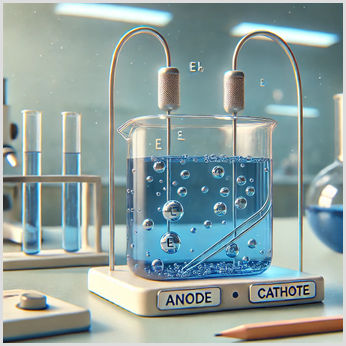Electrolysis is a chemical process that uses electricity to break down substances. It is used to extract metal and electroplate and produce chlorine. Electrolysis helps us to understand essential concepts about ionic compounds, electron transfer and redox reactions. It has significant practical applications, such as extracting aluminium from bauxite and producing hydrogen fuel.
This study guide will explore the principles of electrolysis and its applications in the real world. It is suitable for GCSE Chemistry students - GCSE combined science and single science - and for all major exam boards, including AQA. If you need support learning this topic, TeachTutti has qualified GCSE Science tutors who can help you learn about and revise electrolysis, such as making revision notes.
What is Electrolysis?
Electrolysis uses electricity to break down an ionic compound into its elements. It requires molten ionic compounds or one in a dissolved (aqueous) state. This allows the ions to move and carry charge.
The movement of ions in an electrolyte is crucial to electrolysis:
- Positive ions (cations) move towards the negative electrode (cathode) when an electric current flows. This gives the ions electrons, which is called reduction.
- Negative ions (anions) move towards the positive electrode (anode) and lose electrons when an electric current is passed. This loss of electrons is called oxidation.
Key Electrolysis compounds:
- Electrolyte – A molten or dissolved ionic compound that conducts electricity.
- Anode – This is the positively charged electrode. It attracts negative ions (anions) and triggers oxidation.
- Cathode – This is the negatively charged electrode. It attracts positive ions (cations) and causes reduction.
- Power supply – This is the electrical current that drives the reaction.
The mnemonic PANIC is a useful way to memorise the charge of electrodes: Positive Anode, Negative Is Cathode.
1
Which statement best describes electrolysis?
The process of Electrolysis
Electrolysis works when electricity from a power source passes through an electrolyte. This makes ions gain or lose electrons when they move towards the oppositely charged electrode. It triggers the following electrolysis reactions:
- Reduction - The negative electrode (cathode) causes positive ions to gain electrons.
- Oxidation - The positive electrode (anode) causes negative ions (anions) to lose electrons.
When the ions move towards the electrodes and create reduction and oxidation, they form new substances inside each electrode.
Step-by-step breakdown of electrolysis:
- Electric current is applied - A direct current power supply is connected to two electrodes, which are placed in the electrolyte.
- Movement of ions - The free ions move. Positive ions (atoms that have lost an electron) move to the cathode and negative ions (atoms that have gained an electron) move to the anode.
- Electron transfer - Positive ions gain electrons (reduction) and negative ions lose electrons (oxidation).
- Formation of new substances – These substances can be metals, gases, or non-metals.
An example is the electrolysis of sodium chloride (NaCl). Chloride ions (Cl-) move to the anode and create Chlorine gas (Cl2). Hydrogen ions (H+) move to the cathode and create hydrogen gas (H2).
The mnemonic OIL RIG helps us to remember the electron transfer process: Oxidation Is Loss (of electrons), Reduction Is Gain (of electrons).
2
What happens at the negative electron during electrolysis?
Electrolysis of molten salts (ionic compound)
The ions can move freely when an ionic compound is melted, allowing electrolysis. This molten compound splits into its elements: metals form at the cathode and non-metals form at the anode.
For example, the following reactions take place when molten sodium chloride (NaCI) undergoes electrolysis:
- Sodium ions gain electrons at the cathode. This creates sodium metal at the cathode. This is the reduction: Na+ + e_ -> Na
- Chlorine ions (Cl-) lose electrons and create chlorine gas at the anode. This is the oxidation: 2Cl- -> Cl2 + 2e-
Remember that metals that are formed occur at the cathode while the non-metals that are created occur at the anode (the exception being hydrogen). Molten salts never contain water so there won't be competing reactions from H+ or OH- ions.
3
In the electrolysis of molten sodium chloride, what is formed at the anode?
Electrolysis of aqueous solutions (ionic compound)
Electrolysis is more complicated when an ionic compound is dissolved in water. Water contains hydrogen ions (H+) and hydroxide ions (OH-), which can take part in the reaction and compete with the ions from the dissolved compound.
We can use the following checks to discover the products formed in the electrolysis of aqueous solutions:
- Cathode - The less reactive ion is discharged. Metal is deposited when the metal ion is less reactive than hydrogen e.g. copper and silver. Hydrogen gas is created when the metal ion is more reactive than hydrogen.
- Anode - The Halide ions (Cl-, Br-, I-) are discharged first. This creates chlorine, bromine, or iodine gas. If there aren't any halide ions, hydroxide ions (OH-) lose electrons and create oxygen gas (O2).
For example, let's look at the electrolysis of Copper(II) Sulfate Solution (CuSO4):
- Cathode - Copper ions (Cu²+) gain electrons and are deposited as copper metal. This is the reduction: Cu²+ + 2e- -> Cu
- Anode - Hydroxide ions (OH-) lose electrons and form oxygen gas and water. This is the oxidation: 4OH- -> O2 + 2H2O + 4e-
Another example is the electrolysis of Sodium Chloride Solution (NaCl) (Brine):
- Cathode - Hydrogen gas is produced because sodium is more reactive than hydrogen. This is the reduction: 2H+ + 2e- -> H2
- Anode - Chlorine gas is produced because chloride ions are discharged instead of OH-. This is the oxidation: 2Cl- -> Cl2 + 2e-.
4
What gas is produced at the cathode in the electrolysis of aqueous sodium chloride?
Oxidation and reduction
The two key chemical reactions in electrolysis are oxidation and reduction. These reactions happen at the electrodes when ions gain or lose electrons.
- Oxidation - the loss of electrons at the positive electrode.
- Reduction - the gain of electrons at the negative electrode.
The electrolysis of Aluminium Oxide (Al2O3) is an example of these reactions:
- It is called the Hall-Héroult process and is the major industrial process for smelting aluminium.
- The uses of aluminium include making aircraft, vehicles and packaging materials.
- This process takes place in the compound molten cryolite (Na3AlF6), which lowers the melting point of aluminium oxide.
- Cathode - Aluminium ions (Al³+) gain electrons to create aluminium metal. This is the reduction: Al³+ + 3e- -> Al
- Anode - Oxide ions (O²-) lose electrons to form oxygen gas. This is the oxidation: 2O²- -> O2 + 4e-
5
What happens at the anode (positive electrode) during electrolysis?
Chemical tests (GCSE Chemistry practical)
GCSE Chemistry requires students to investigate the electrolysis of aqueous solutions. The experiment described below expects you to identify the products formed at the electrodes. You need to understand the reactions taking place.
You will need the following:
- Beaker with electrolyte solution, such as copper sulfate or sodium chloride).
- Two inert electrodes. Carbon or platinum is fine.
- DC power supply to provide an electric current.
- Test tubes to collect any gases that are created.
Experiment method
- Create the electrolysis circuit. Make sure the electrodes are fully submerged in the electrolyte.
- Connect the electrodes to a DC power supply. Turn the power on.
- Look for any gas bubbles or metal deposits at the end of the electrodes.
- Test for gases produced at the electrodes: Hydrogen - A lit splint makes a squeaky pop | Oxygen - A glowing splint relights | Chlorine - A damp blue litmus paper will turn white (bleached)
- Record your observations and note the products formed.
For example, let's look at the electrolysis of Copper(II) Sulfate (CuSO4) solution:
- Cathode - Copper ions (Cu²+) gain electrons and are deposited as copper metal. This is the reduction: Cu²- + 2e- -> Cu
- Anode - Hydroxide ions (OH-) in the water lose electrons. They create oxygen gas. This is the oxidation: 4OH- -> O2 + 2H2O + 4e-
A metal is deposited at the cathode is the metal ion is less reactive than hydrogen in aqueous solutions. If not, hydrogen gas is released.
6
What gas is created at the anode during the electrolysis of copper(II) sulfate solution?
Real-World applications
Electrolysis is widely used in industries and everyday applications. It is important in extracting metal, such as when aluminium is obtained from their ores. As discussed, the Hall-Héroult process produces aluminium by electrolyzing molten aluminium oxide. This manufactures lightweight metals used in items as diverse as vehicles and electronics.
Electroplating coats objects in a thin layer of metal. This is used to improve the appearance of an item or to reduce corrosion. Jewellery, cutlery and car parts are often electroplated with gold, silver, or chromium to make them more durable. The process makes the object the cathode, where metal ions from the electrolyte deposit onto its surface.
Chlorine gas is created at the anode when brine (sodium chloride solution) undergoes electrolysis. This is used in disinfectants, plastics and bleach. Hydrogen gas is produced at the cathode and can be used for lean fuel. Oxygen is also created in electrolysis and has varied uses in applications, including medical treatment and industrial processes.
The use of hydrogen fuel production through electrolysis is becoming increasingly important as the world looks to develop cleaner energy sources in the face of climate change. Water electrolysis splits water into hydrogen and oxygen. Hydrogen is a key component of fuel cells that generate electricity for vehicles and power grids.
7
Which industrial process uses electrolysis to extract aluminium?
Conclusion - Electrolysis revision
Electrolysis allows the breakdown of ionic compounds using electricity. It is crucial in metal extraction, electroplating, chlorine production and the development of cleaner energy through hydrogen fuel. Understanding the process of electrolysis can explain many applications in the world around us, from the movement of ions to the reactions at each electrode.
For further reading, you can test your knowledge with past paper questions. ExamPapersPractice has focussed questions on electrolysis, while StudyMind has AQA GCSE Chemistry past papers.
If you need support revising this topic, consider learning with TeachTutti's GCSE Science tutors. All our tutors are qualified and DBS-checked. Lessons can be in-person or online using TeachTutti's learning platform.

